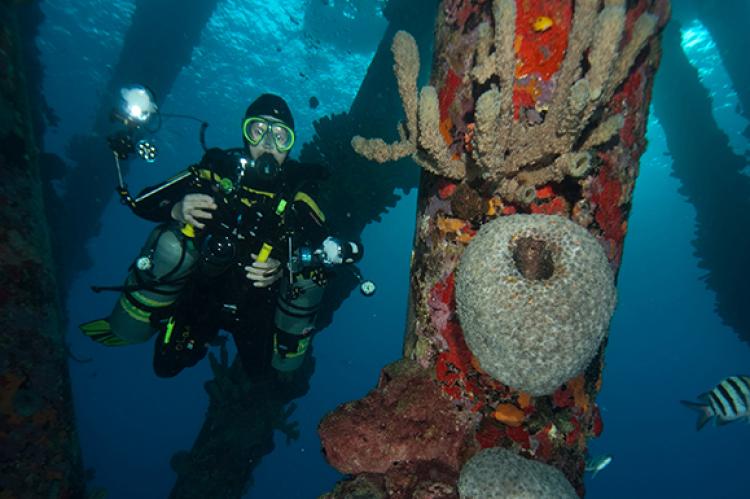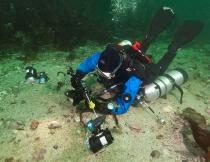Holy Sidemount!
Judging from the recent spate of PADI ads, we’re in the midst of a new “Tec Revolution”. The last one was reportedly when the training behemoth launched its TecRec program 2000, or so the blog said.
This of course makes for good copy for the uninitiated—diving companies have long used tech sizzle to sell gear and training to recreationalists—but the fact is, it’s a bit of marketing hyperbole.
Full disclosure: I was there for the original stage bottle toting, trimix breathing, nitrox and oxygen decompressing, deep diving technical revolution in the late 80's early 90's. In fact, my magazine aquaCORPS Journal covered the revolt—from the first shots fired in places like Wakulla Springs and Key Largo, Florida, to later developments that enabled explorers to splash down on wrecks like the U-Who or HMHS Britannic, and PADI was not in the mix!
But don’t get me wrong. Privately held PADI Inc., the self-proclaimed “Way the World Learns to Dive”, is indeed fomenting a revolution! But it’s not about tech diving. It’s aimed at PADI’s traditional base of recreational divers and instructors, so call it what it is: a “Rec Revolution”. Furthermore, 2012 may well represent the tipping point.
Historically, PADI has been slow to adapt to technology innovations. While enriched air nitrox (EAN) diving was introduced to sport divers in the late 1980s, PADI waited until 1995 to introduce its own EAN program. Similarly, throughout the 90's the company watched the development of tech diving from the sidelines, but didn’t launch its TecRec program until a decade later, and then only after several tech-training agencies launched competing recreational courses.
PADI was also one of the sponsors of Rebreather Forum 2.0, which I organized with Tracy Robinette in 1996, but essentially has remained out of the loop on rebreather technology, which until recently, had been for the most part an exclusive tool for high end technical divers.
But now the marketing juggernaut, which boasts nearly 6,000 affiliated dive centres and more than 135,000 members, is taking the lead in helping to create a market and aggressively promote rebreather diving recreational divers. Granted, PADI is also offering a tech diving program, but it does not represent a notable change from what’s already available.
Conversely, the coming of recreational rebreathers has been prophesized for nearly 50 years—ever since Walter Stark invented the “Electrolung” in the late 60's. Judging from history, it’s a task far easier said then done, and not without controversy!
Sidemount diving is gaining popularity
Proponents like James Roberton, executive VP of sales at Poseidon Diving Systems AB which manufacturers a recreational rebreather, says that offering well-heeled divers the ability to dive in silence while doubling or more their no-stop bottom times will revolutionize sport diving market and reverse its declining numbers. He compares recreational rebreathers to the introduction of snowboards in the late 70's, which reinvigorated the then stagnant skiing industry and helped it grow by a factor of 60 times over the following 25 years.
However, critics like Jarrod Jablonski, CEO of Global Underwater Explorers, and Halcyon Inc., which makes a rebreather for tech divers, are concerned that with their complexity, maintenance requirements, and a fatality rate that may be as high as 5-10 times that of open circuit scuba (no one knows for sure), the benefits of closed circuit rebreathers, which are statistically 20 times more likely to fail than a twin set, simply don’t justify the risks for recreational divers who lack the necessary skills and experience. They worry that a rash of recreational rebreather deaths would hurt the diving business as a whole.
At the heart of the issue is whether manufacturers, like Poseidon and others can successfully build a new generation of easier-to-use, fault tolerant rebreathers—Type R machines in PADI parlance—that can monitor and analyse the user’s breathing gas and other on-board systems better than a well-trained diver, and in case of a problem, alert the diver and act to keep her alive.
The ultimate test will likely be whether rebreather fatality rates can be kept at levels approaching that of open-circuit diving. PADI and others believe this is achievable by standardizing on smarter, “idiot-resistant” machines and limiting their use to the traditional recreational envelope i.e. no-stop diving to 40m or less.
Viva la Rec Revolution?
My hope is that these issues and others will be vigorously debated, and at some length, at the upcoming Rebreather Forum 3.0 conference, which PADI is organizing with Divers Alert Network and the American Academy of Underwater Scientists (AAUS), 18-20 May 2012 in Orlando, Florida. Clearly, the ‘breather’ is in their court! ■
Read more about sidemount training here:
Sidemount Workshop: A matter of comfort, by Olga Torrey
http://www.xray-mag.com/content/sidemount-workshop-%E2%80%93-matter-comfort



